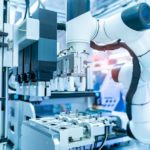 The debate around whether AI will take our jobs seems to have been going on forever now, but certainly gathered pace in 2014 with the release of Oxford academic Carl Frey’s paper looking into the impact of automation on jobs. These concerns have gathered pace again since the emergence of generative AI tools, like ChatGPT. I’ve covered studies exploring the impact of genAI on the freelance market (negative) and also ones looking at the boost it provides to managers after AI is invested in.
The debate around whether AI will take our jobs seems to have been going on forever now, but certainly gathered pace in 2014 with the release of Oxford academic Carl Frey’s paper looking into the impact of automation on jobs. These concerns have gathered pace again since the emergence of generative AI tools, like ChatGPT. I’ve covered studies exploring the impact of genAI on the freelance market (negative) and also ones looking at the boost it provides to managers after AI is invested in.
A third study, from IESE in Spain, looks more broadly at the knowledge economy to understand the potential impact of AI. The rapid progress of artificial intelligence (AI) in the past decade has sparked debate about its effects on society. Will it spread opportunities widely or concentrate power and wealth in a few hands? To explore this, the researchers built a model of a knowledge economy where humans and AI-powered machines work together to solve complex problems.
Matching abilities
The model shows that AI’s impact on workers’ earnings depends on how well it can match human abilities. When AI improves in areas where it still lags behind humans—failing what’s known as the Turing Test—workers’ incomes tend to drop. But when AI gets better in areas where it already matches human abilities, incomes rise. This means that as AI develops, workers’ incomes might fall at first before recovering, depending on how AI evolves.
The study also highlights a potential conflict: the AI that benefits workers the most may not be the same as the one that maximizes profits for investors. Policymakers will need to navigate these competing interests. For instance, income support during periods when workers’ earnings fall could ease resistance to AI adoption. Policymakers could also encourage investment in technology that fosters better collaboration between humans and machines.
This model could also help tackle other questions, such as how AI affects income inequality. Future research could build on this work to better understand the challenges and opportunities created by AI.
New jobs
In all likelihood, the widespread adoption of generative AI is likely to see a number of new jobs being created. I’ve mentioned the research showing growth in the number of managers, for instance, as organizations redesign the ways in which they work to better utilize the new capabilities AI provides them, but this is far from the only area ripe for growth.
In Superagency, LinkedIn co-founder Reid Hoffman highlights the mental health challenges we face as a society, and especially the often crippling shortage of professionals skilled enough to provide us with the support we so desperately need. While there is a growing tendency for people to actually talk to ChatGPT and other mental health chatbots, the growing availability of mental health services is likely to increase the market considerably, with Hoffman arguing that we’ll move away from viewing mental health services as something we access only during crises to something we access on an ongoing basis, much as we do a gym. It’s a version of Paul Krugman’s famous hot dog analogy, whereby reductions in the price of one item don’t reduce jobs as they significantly increase the size of the overall market.
The use of AI could also augment the work of human mental health professionals in a way that Hoffman draws comparisons to Netflix and Spotify, which both use data to inform what we get and provide us with accessible and economical video and music services that are configured to our individual desires.
Healthcare boom
This extension in the provision of healthcare is unlikely to be confined to mental health. For generations, healthcare has suffered from “Baumol’s cost disease”, which has meant that costs have remained stubbornly high, even as other sectors of the economy have become more efficient. This has helped to create the shortage of service provision Hoffman describes in mental healthcare, but it’s a problem that is just as pronounced in other parts of the system too.
Technology promises to make this better, with advances in genome sequencing and AI-assisted research expanding possibilities in biology, neuroscience, and health sciences. Though current government forecasts predict modest growth, recent breakthroughs suggest a more optimistic trend, with job creation potentially tripling official estimates.
The job market is changing in ways that are both promising and concerning. In areas such as healthcare and management, there is clear potential for jobs to be added, with these gains likely to outweigh the number who might lose their jobs due to automation, especially in roles like telemarketing, customer service, and administration. But there’s a catch. Many of the new positions require specialized education or experience, which laid-off workers may find hard to acquire. On top of that, the rise in managerial roles may come more from promotions and reclassifications than from creating new opportunities.
This trend highlights a troubling pattern. While experienced workers may find plenty of opportunities, young people could face a much tougher time, particularly if schools fail to teach the skills needed for jobs in AI-driven industries. Unemployment, which has ticked up slightly in 2024, is hitting under-25s hardest. Governments at all levels will need to pay close attention to this growing gap.